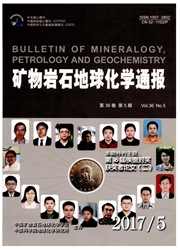

 中文摘要:
中文摘要:
为探讨石窑沟钼矿床的矿床成因,本文开展了系统的地质及成矿流体特征研究。根据矿脉穿切关系,将热液成矿过程分为早、中、晚3个阶段,其矿物组合分别为石英-钾长石-黄铁矿-辉钼矿、石英-多金属硫化物和石英-方解石±黄铁矿。研究发现,成矿早、中阶段产出的石英中有水溶液包裹体、纯CO2包裹体、H2O-CO2类包裹体和含子晶多相包裹体,而成矿晚阶段产出的石英中仅有水溶液包裹体;对不同阶段包裹体的显微测温和激光拉曼测试结果显示,成矿早阶段成矿流体以高温、高盐度、高氧化性、富CO2为特征;中阶段流体发生沸腾,导致CO2逃逸,还原性增强,成矿物质沉淀;晚阶段流体以低温、低盐度、贫CO2为特征。流体沸腾可能是引起辉钼矿沉淀的重要原因。
 英文摘要:
英文摘要:
This paper systematically studied on geology and ore-forming fluids in the Shiyaogou molybdenum deposit and discussed the nature and evolution of the ore-forming fluids. According to the crosscutting relationship of ore veins,the hydrothermal ore-forming process can be divided into early,middle and late stages,in which the characterized mineral assemblages of the hydrothermal ore-forming fluid were quartz-potash feldspar-molybdenite-pyrite,quartz-polymetallic sulfides and quartz-calcite±pyrite,respectively. There four types of fluid inclusions,Na Cl-H2 O,pure CO2,CO2-H2 O and daughter mineral-bearing fluid inclusions were found in the quartz of the early and the middle stages,while only one type of fluid inclusions,Na Cl-H2 O inclusions,were found in the quartz of the late stage. Microscopic date,including compositions,homogeneity temperature and salinity,of fluid inclusions from different stages demonstrated that the early stage ore-fluids were characterized by high temperature,high salinity and high content of CO2,the middle stage ore-fluids underwent a rapid precipitation of ore-forming materials since of fluid boiling and CO2 releasing,and the late stage ore-fluids were characterized by low temperature,low salinity and low content of CO2. It implied that the fluid boiling process might be the dominant factor for molybdenite deposition.
 同期刊论文项目
同期刊论文项目
 同项目期刊论文
同项目期刊论文
 期刊信息
期刊信息
